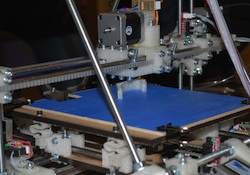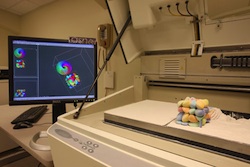Additive Manufacturing – Something from Nothing
 Thirty years ago, if you wanted to make something, you’d take a big brick of metal, then cut and melt away until you had the shape you were looking for. It works, but it’s not exactly optimal. There simply wasn’t any other way, though. Meanwhile, emulating nature – which builds new things from nothing, rather than whittling stock down – is always a good approach for those seeking optimal processes. And the rise of 3D printing does exactly that, if a little less elegantly than a sequoia popping from a pine nut.
Thirty years ago, if you wanted to make something, you’d take a big brick of metal, then cut and melt away until you had the shape you were looking for. It works, but it’s not exactly optimal. There simply wasn’t any other way, though. Meanwhile, emulating nature – which builds new things from nothing, rather than whittling stock down – is always a good approach for those seeking optimal processes. And the rise of 3D printing does exactly that, if a little less elegantly than a sequoia popping from a pine nut.
USA Today opines that 3D printing (or additive manufacturing, as it’s more descriptively called) could remake American manufacturing in a new image. Additive manufacturing has come into its own in the past few years, barreling past its embryonic application as a rapid prototyping tool. Parts made via additive processes are increasingly on par with their more traditionally-manufactured brethren: everything from strength to surface texture has improved dramatically. The process, which assembles whole parts by essentially spraying or bonding miniscule layers of feedstock together until a three-dimensional object is formed, remains slower and more expensive than the traditional approaches. But even that is expected to change with time. Ultimately, it’s more flexible, produces less waste, copes better with design changes, and is much friendlier to the creation of complex geometries than conventional tooling. All that really needs to happen is for the technology to catch up with its potential.
And the catch-up, apparently, is not far down the road. Enormous manufacturers like Boeing are increasingly using additive processes for parts despite the slightly higher up-front cost; flexibility and weight reductions offset such concerns in the long run, and as additive continues its upward trend there’s little doubt that the costs will plummet.
Traditional manufacturing has another drawback not shared by additive: its value is based heavily in the assumption that parts be produced en masse, because it costs a lot of money to produce custom tooling required for most parts. Additive doesn’t have that issue; no tooling is required at all. The machines simply squirt feedstock into a shape based on easily-changed models fed to them by a computer – hence the printing analogy. That means limited runs, or even single custom parts, can be readily produced without incurring significant extra cost. Try ordering one part from a regular tooling facility and see how fast they hang up the phone.
 For all its shortcomings, traditional manufacturing does employ (or used to employ) a lot of people; additive manufacturing is much more heavily automated. And workers seeking employment in additive environments will need advanced skills not often held by the manufacturing personnel of old. It’s a digital process for a digital age, and if the country hopes to capitalize on the manufacturing boon it represents, education will likely be a necessary starting point.
For all its shortcomings, traditional manufacturing does employ (or used to employ) a lot of people; additive manufacturing is much more heavily automated. And workers seeking employment in additive environments will need advanced skills not often held by the manufacturing personnel of old. It’s a digital process for a digital age, and if the country hopes to capitalize on the manufacturing boon it represents, education will likely be a necessary starting point.
But as larger manufacturers adopt additive processes, and dozens or hundreds of smaller innovators focus on advancing the technology, there can be little doubt that this represents a major shift in manufacturing opportunities. The nascent technology, once stuck in the realm of short-run rapid prototyping due to limitations and expense, stands poised to completely recreate the way America builds things… and do it from the ground up.










